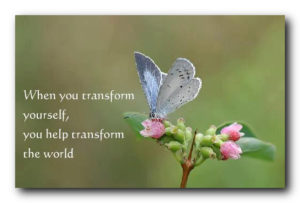When children are born they experience complete connection, oneness, with everything around them. The child and mother have a symbiotic relationship which means the child does not perceive itself as different from the mother; the mother and child are one. Over time a child begins to develop a sense of self. The child’s experience is “oh no, I am me and there are a lot of things that aren’t me. I am separate from the world.” This creates a type frustration with the loss of oceanic oneness. As the child grows, he or she experiences other levels of separation. The experience includes a difference within the self. The child wonders about the person they are and the person they would like to be; who I am and who I want to be. The child questions the difference between the life being lived and the life they want to live.
 The experiences of separations create a sense of lack and a sense of identity that compares and attempts to compensate for that sense of lack. These experiences take years to accumulate to a sense of self, an ego that provides the foundation for how the world is perceived, interpreted, responded to, and interacted with. The experiences of separateness continue beyond childhood and adolescence into adult life. Our spiritual development during childhood, adolescence, and early adulthood help us learn how to understand and behave to the identity of otherness. As adults, our spiritual develop is primarily concerned with how to heal the identity of otherness. We yearn to return to oneness, connection with everything, and deeper richer relationships.
The experiences of separations create a sense of lack and a sense of identity that compares and attempts to compensate for that sense of lack. These experiences take years to accumulate to a sense of self, an ego that provides the foundation for how the world is perceived, interpreted, responded to, and interacted with. The experiences of separateness continue beyond childhood and adolescence into adult life. Our spiritual development during childhood, adolescence, and early adulthood help us learn how to understand and behave to the identity of otherness. As adults, our spiritual develop is primarily concerned with how to heal the identity of otherness. We yearn to return to oneness, connection with everything, and deeper richer relationships.
The sense of otherness amasses differently for each person to varying degrees of self-centeredness, self-deception, self-preoccupation, self-honesty, and ignorance. This is the core of illness from out of which we think, decide, and act. The illness is exacerbated as we become sidetracked by our conditioning, families, peer group, and the negative influences of an intoxicating culture that dispenses the narcotics of dissipation and superficiality. The work to be done is transformation; actualizing our potential for higher form of life. Transformation from this illness to other-centeredness, self-honesty, clarity, truth, love, sincerity, wisdom, virtue, compassion, mercy, kindness, genuine wholeness, and the liberating power of grace. To engage in transformation means to work towards a quality of inner change and a radical reordering and alteration of our character, and all our old habits of thought, feeling, and action.
Transformation via the spiritual journey changes us to the core of our being by seeking the real, not illusion and entertainment. Otherwise the personal cost is great, deeper ignorance, confusion, despair, and less authenticity. Healing transformation includes developing our consciousness, will, emotions, character, imagination, memory, and actions or behavior.
As awareness (consciousness) grows and expands, it takes in more. The more it expands the greater its capacity becomes to understand, to change, to actualize our image of the divine. Understanding increases, ignorance dissipates, outgrow and alter selfish motives. As consciousness expands our will recognizes inner change. The will desires good that transcends self-concern and preoccupation and responds to others with love and compassion. Additionally the will desires wisdom, spiritual knowledge, the virtues, mystical awareness, unitive vision, and attaining higher spiritual life.
 Like our will, expanded consciousness helps emotions achieve a greater stability and order. They no longer operate on their own, but are brought into harmony with the integral person. This revived harmony guides us toward the holiness radiant with the virtue of a loving presence. Emotions begin to serve the spiritual journey and are no longer a source of distraction. Likewise, memory becomes of service to the person’s inner growth. It no longer sits isolated and wallowing in its hurts, injuries, and traumas of earlier life, and becomes present to the eternal now.
Like our will, expanded consciousness helps emotions achieve a greater stability and order. They no longer operate on their own, but are brought into harmony with the integral person. This revived harmony guides us toward the holiness radiant with the virtue of a loving presence. Emotions begin to serve the spiritual journey and are no longer a source of distraction. Likewise, memory becomes of service to the person’s inner growth. It no longer sits isolated and wallowing in its hurts, injuries, and traumas of earlier life, and becomes present to the eternal now.
Imagination is united to our understanding, will, character, memory and actions. Imagination integrates the effective center of willing, knowing, acting, and being. It doesn’t operate irrespective of what is happening in our inner life. When these levels of transformation are active and in harmony, there is less hypocrisy and more sincerity. We are able to experience fruition in selfless love, compassion, mercy, and kindness.
A mature integrated spiritual life transforms our action and behavior to conform to love; to act in harmony with compassion and practical wisdom, which knows the sufferings of others and the appropriate responses to those sufferings. Authentic transformation integrates inner change and outer action, or it is not authentic or complete. Transformation leads us to a healthy spiritual life. The elements of a healthy spiritual life include: (1) actualized moral capacity, (2) solidarity with the earth and all beings, (3) deep nonviolence, (4) humility of heart, (5) spiritual practice, (6) mature self-knowledge, (7) simplicity of life and lifestyle, (8) love in action – compassionate service, and (9) prophetic voice and action. See description of the nine elements here.

|
Identity in otherness confusion despair ego hypocrisy ignorance less authenticity self-centeredness self-deception self-preoccupation sense of lack sense of self |
clarity compassion connection with everything deeper richer relationships genuine wholeness higher spiritual life holiness kindness love mercy oneness other-centeredness self-honesty sincerity spiritual knowledge truth unitive vision virtue wisdom
|
|
consciousness will emotions character imagination memory actions behavior |
actualized moral capacity solidarity with the earth and all beings deep nonviolence humility of heart spiritual practice mature self-knowledge simplicity of life and lifestyle love in action – compassionate service prophetic voice and action |
[Reference: The Mystic Heart by Wayne Teasdale]
